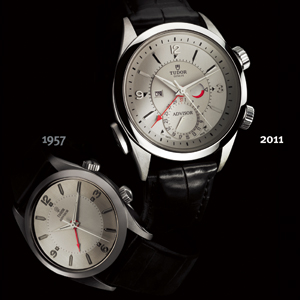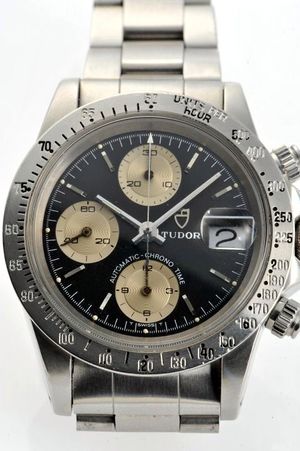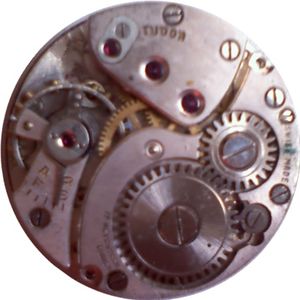Tudor/en
Tudor
“For some years now I have been considering the idea of making a watch that our agents could sell at a more modest price than our Rolex watches, and yet one that would attain the standards of dependability for which Rolex is famous. I decided to form a separate company, with the object of making and marketing this new watch. It is called the Tudor Watch Company.” This announcement was made on 6 March 1946 by Hans Wilsdorf who, having created Rolex in the first decade of the 20th century, was already a leading figure in the upmarket Swiss watchmaking world. It marked the birth of both the TUDOR brand and its production and communications strategy.
Hans Wilsdorf’s intuition was as simple as it was ingenious. At that time, the development of wristwatches was in full swing and today’s widespread drive to optimize resources, which is currently behind so many major financial and brand mergers, was still in the far-distant future. The public was ready to recognize and appreciate a product whose technical, aesthetic and functional qualities, as well as its distribution, were guaranteed not by a newcomer on the market but by the Rolex brand, which had already earned worldwide renown for the high quality of its timepieces. This announcement was not merely words said for effect. It was Wilsdorf’s genuine commitment to a programme. Between 1947 and 1952, therefore, TUDOR devoted itself to launching first the TUDOR Oyster model, followed by the TUDOR Oyster Prince collection, reflecting the successful marriage of precision and reliability, style and technique and high-quality production. That period also saw the emergence of the first advertisements devoted exclusively to TUDOR, in which Wilsdorf expressed pride and satisfaction regarding his personal involvement in creating this new brand. This certainly was a privileged and auspicious start for the TUDOR brand, originally represented by a decorative rose, the famous symbol of a once long-reigning dynasty in England, the Tudors, who inspired Hans Wilsdorf to give their name to his new company. This famous name, however, never led the company to rest on its laurels. From the very beginning, this was a story of technical developments, like the waterproof Oyster case and the adoption of a self-winding movement, which were not relegated to mere functionality, but turned into stylish features of watches designed in both performance and appearance for modern, dynamic men. With Rolex to usher it into the world and accompany its first steps, the TUDOR brand very quickly carved out a niche for itself, quite independently of the brand with the five-prong crown.
If we look closely, early traces of TUDOR and its creations can be found as far back as 1926, the year the brand was registered by the Swiss watchmaking company “Veuve de Philippe Hüther” on behalf of Hans Wilsdorf. In 1936, Wilsdorf took it over himself, and went on to found the company Montres Tudor SA in 1946. It was, however, the products and advertising campaigns of the 1950s that really gave the brand its definitive strength and distinctive personality.
The year 1952, in particular, saw the launch of the TUDOR Oyster Prince, accompanied by a press campaign that was very intense, strong and original for the period. The advertisements not only showed and described the watches, as was customary at the time, they also underlined the qualities of resistance, reliability and precision, with both detailed text and illustrations. These illustrations depicted men at work wearing a TUDOR in extreme conditions, doing strenuous work on a road or in a mine, for instance, and not strictly in sports settings, such as motorcycling, playing golf or riding horses, which were also effective test situations but far more conventional. The images, together with the, by then, widely recognized soundness of the product, helped give TUDOR watches a style and personality associated with concepts of modernity and reliability, and launched it well beyond the particular context in which it was being shown.
It is significant that 30 TUDOR Oyster Prince watches were included in the British scientific expedition to Greenland organized by the Royal Navy in 1952. In the wake of its technological triumphs and the success of its image, brought about by its participation in the Polar explorations, the TUDOR brand in the 1960s became involved in a project to develop a professional underwater watch that could become a piece of official military equipment. A TUDOR Prince Submariner was produced for the US Navy from 1964 to 1966, followed in the early 1970s (and until 1984) by the “Marine Nationale” model, which was officially adopted by the French Navy.
And so for TUDOR began the era of stylish watches of a more technical design, inspired by professions regarded as dangerous. They were therefore endowed with particular functional features – for example, divers’ models with date or chronograph function – and a style that radiated strength, security and reliability. The people selected for the TUDOR Prince Submariner and TUDOR Prince Date-Day advertising campaign at the time were not well-known personalities, which made it easier for the public to identify with them. They included rescue divers, mining engineers or rally drivers whose full names were given, and who were photographed with their equipment, conveying perfect mastery of their professions.
In 1970 a model was introduced that stood out for its style and technology: the TUDOR Oysterdate Chronograph. The spirit of this timepiece foreshadowed TUDOR’s present collaboration with Porsche Motorsport as its “Timing Partner”. This role is reflected in the Grantour collection, shown for the first time at Baselworld 2009, the year that saw a complete rethinking of the TUDOR brand, resulting in the new series of watches and the advertising campaign: “Designed for Performance. Engineered for Elegance.” TUDOR’s communication has evolved since the advertising campaigns of the 1980s featuring distinctive details from knightly armour to communicate resistance, also achieved in the change of logo from rose to shield. This repositioning of the brand, yet again emphasizing the marriage of performance and style, continues to be evident in the new designs for 2010.
The Evolution of the logo
For obvious, image-related reasons, great importance has always been accorded to the logo that generally appears with the brand name on a watch dial. TUDOR is no exception to this rule. Indeed, it has paid particular attention to its own logo, adapting it over the years in response to specific communication needs.
The very first watches produced in the 1920s and 1930s simply bore the name TUDOR, as a kind of birth certificate. A few rare models associated the name TUDOR with Rolex, corresponding to the fact that Rolex originally guaranteed the technical and aesthetic quality of TUDOR, which the brand later went on to develop autonomously.
It was around 1936 that a graphic symbol first appeared, the delicate TUDOR rose, emblem of the long-reigning English dynasty to which the brand owes its name. The rose was shown on a shield, as if to symbolize the invincible union of strength and beauty.
In 1947, just a year after TUDOR was officially launched, the brand name on the dial was accompanied by the rose alone, highlighting TUDOR’s consummate elegance and style. Between 1969 and the present day, as the requirements of classical aesthetics were definitively met and TUDOR production focused increasingly on technical aspects, the rose disappeared from the shield, which remained on the dial in pride of place, a powerful symbol of resistance and reliability.
Brief chronology
1926 - “The Tudor” brand was registered by the Swiss watchmaking company “Veuve de Philippe Hüther” on behalf of Hans Wilsdorf
1936 – Hans Wilsdorf himself took over “The Tudor” brand
1946 – the company “Montres Tudor SA” was established in Geneva on 6 March
1947 – launch of the TUDOR Oyster model
1948 – first exclusively TUDOR advertising campaign
1952 – launch of the TUDOR Oyster Prince collection
1957 – launch of the TUDOR Advisor model
1964 – production (for two years only) of a TUDOR Prince Submariner for the US Navy
1969 – launch of the TUDOR Prince Submariner and TUDOR Prince Date-Day models
1970 – launch of the TUDOR Oysterdate Chronograph
1971 to 1977 – TUDOR Oysterdate Chronograph
1977 to 1996 – TUDOR Oysterdate Chronograph (Automatic-Chrono Time)
1991 – launch of the TUDOR Monarch collection
1996 to 2006 – TUDOR Prince Date Chronograph (Automatic-Chrono Time)
1999 – launch of the TUDOR Hydronaut collection
2007 – international relaunch of the TUDOR brand with new products (Tudor Classic and Tudor Hydronaut II collections) and a new communications campaign
2009 – presentation of the new range, with new TUDOR Hydronaut II, TUDOR Hydro1200, TUDOR Glamour and TUDOR Grantour. TUDOR begins collaboration with Porsche Motorsport, as “Timing Partner”. Launch of the campaign: “Designed for Performance. Engineered for Elegance.”
2010 – launch of new TUDOR Heritage Chrono and TUDOR Glamour Double Date models
A new direction
For TUDOR, 2009 marked a decisive turning point. This was the year the brand underwent a major repositioning, with a strong enhancement of its products’ identity and its communications strategy, which was transposed into the competitive world of car racing at the side of none other than Porsche Motorsport, the entity that organizes and manages all competitions for Porsche racing cars.
After having ridden for a number of years the wave of success created at its inception by acclaim from both the public and experts, TUDOR recently decided to assert more forcefully its own modern identity, based on the delicate balance between performance and elegance. This led to a totally new range of products and a relationship with the Stuttgart car manufacturing firm, rich in stylistic and technological synergies. As of 2009 and in the years to come, TUDOR would be the “Timing Partner” of Porsche Motorsport.
TUDOR chose in particular to work with Porsche Motorsport on the Supercup, a race series in which the vehicles are all identical Porsche 911 GT3 Cup Type 997 cars, derived from the Porsche 911 Carrera.
The target audience for TUDOR has always been identified as dynamic young people with confidence in their own choices, wishing to wear without pretension timepieces reflecting the style and high standards they set for themselves. Watches that evoke elegance, sports, style and performance. Men and women who have a comfortable, everyday relationship with beauty – a new generation that is capable of recognizing and appropriating objects whose performance transcends the simple concept of use, transforming them into emotional assets brimming with appeal.
Turning now to the product itself. In 2009 there was a new addition to one of TUDOR’s historic collections, the new Hydronaut II, a watch with a calendar and chronograph function, its details inspired by the nautical world. The new Hydro1200 – a highly technical model – is waterproof to a depth of 1,200 metres and is fitted with a valve which allows the gases that infiltrate the watch during diving to escape as the diver returns to the surface. In TUDOR’s renewed repertoire, this range of distinctly sports watches was accompanied by a collection with a vintage feel, inspired by 1960s style and aptly called Glamour, consisting of classically elegant watches showing date and day and available with different dials, cases and bracelets.
Last but not least is the Grantour collection of watches with a calendar and chronograph function, inspired by the Gran Turismo cars. The link with the motoring world is reflected in aesthetic details such as the black-lacquered steel bezel, reminiscent of on-board instrumentation, and the perforated leather straps giving it a sporty look. The connection is also underscored by the fact that TUDOR is now the “Timing Partner” of Porsche Motorsport and has a presence and visibility on the circuits where Porsche racing cars compete. This association is reinforced by TUDOR’s 2010 models.
The new watches presented by TUDOR at Baselworld 2010 deepen and expand the themes initiated in 2009, with emphasis on a combination of sophisticated elegance and high performance. As is frequently the case for objects imbued with emotional value, form and function are in perfect harmony. Thus, TUDOR perpetuates a style that is recognizable for its accessibility and sophistication. The functionality of a watch in no way detracts from its beauty and, at the same time, its aesthetics in no way diminishes its practicality. A delicate balance, in which aesthetic appeal and pleasure in use reflect the interface of design and technology, is in keeping with the brand’s finest tradition, reliability.
With the new TUDOR Glamour Double Date and TUDOR Heritage Chrono, TUDOR puts theory into practice.
TUDOR Glamour Double Date is a new interpretation of the classical elegance already seen last year in the TUDOR Glamour Date and TUDOR Glamour Date-Day models, a subtle revisiting of 1960s style. This sensual wristwatch for men boasts a round case of generous proportions (42 millimetres in diameter) and a double bezel. The dial, protected by a domed sapphire crystal, is distinctive with its unique open-work feuille hands and a calendar with a double window, surmounted by the current TUDOR shield logo in place of the 12 o’clock marker. Also noteworthy is the small seconds counter, worked in concentric circles and stamped with a stylized rose, inspired by the logo on earlier TUDOR models – a sophisticated note, and at the same time a sign of the brand’s tradition of continuity. Case, bracelet and dial come in many variations. All the watches are waterproof to a depth of 100 metres and feature a self-winding mechanical movement.
The TUDOR Heritage product line represents a further exploration of the most markedly sporty TUDOR collection. This began last year with the new Hydronaut II and Grantour series, and was directly inspired by the mythical TUDOR Oysterdate Chronograph of the 1970s. Stylistic and technical references to the world of car racing abound, from the aerodynamic proportions and decidedly aggressive design to the chronographic function (for measuring short intervals) and the features protecting the crown and pushers. The dial, which comes in grey on black or black on grey, plays on a three-dimensional effect with details in orange, and is complemented by the graduated rotatable bezel in anodized aluminium. The original graphics on the dial are inspired directly by the 1970s Oysterdate, while the case is adapted to present-day sports appeal bringing the diameter of the new TUDOR Heritage Chrono to 42 millimetres, compared to the 40 millimetres of the original. Innovation also triumphs in the bracelet which can be a steel bracelet with a safety clasp, or a unique fabric strap in black, grey and orange with a buckle inspired by the safety belts in the cars of the period.
This new direction that TUDOR has taken since 2009 achieves consistency and continuity. The new models for 2010 and the years to come will only confirm this perfect balance of performance and elegance.
Further information
Address
TUDOR
7, rue François-Dussaud
CH 1211 Genève 26
Tel : ++41 22 302 22 00
Fax : ++41 22 300 22 55



